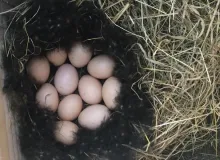
Hottentot Teal (Anas hottentota)
Naamgeving
- Nederlandse naam:
- Hottentottaling
- Engelse naam:
- Hottentot Teal
- Duitse naam:
- Hottentottenente
- Franse naam:
- Sarcelle hottentote
- Wetenschappelijke naam:
- Anas hottentota
Taxonomische indeling
- Orde:
- Anseriformes
- Familie:
- Anatidae
- Onderfamilie:
- Anatinae
- Geslacht:
- Anas
Beschrijving
- Uiterlijke kenmerken:
Male:
Orsal head from eye upward, and hind neck black-brown, ventral head, sides and fore-neck buff with dusky patch on sides of upper neck. Breast and underparts buff with dark brown spots, largest on fore flanks; rear flanks plain buff. Rump blackish, tail-coverts and hind abdomen/ventral region vermiculated buff and blackish. Upperparts dark brown with greyish edges to feathers. Wing black-brown with faint green-blue gloss, secondaries metallic green, black sub terminal band, broad white tips.Female:
The female is duller, crown browner, patch on neck less defined, scapulars shorter, ventral region not vermiculated, seconderies browner.Juvenile:
Same as female but less marked. Appear as adults by first breeding season.
Maten en Gewicht
- Lengte man:
- De man (woerd) van de Hottentot Teal heeft een lichaamslengte van ongeveer 330-350 centimeters. De vrouw (pop) heeft een lichaamslengte van ongeveer 330-350 centimeters.
- Gewicht man:
- Het mannetje weegt ongeveer 216-282 gram. Het vrouwtje weegt ongeveer 224-253 gram.
Het gewicht is notoir variabel en kan alleen als indicatie worden gebruikt!
- Notitie:
Dabbling Ducks are generally hardy, easy to maintain and easy to breed. Shelter may be required by some of the smaller species in winter. They should be provided with cover (including marginal pond cover) and loafing areas as well as water. A pen which is 50% water is suggested. The water may be shallow (i.e. no more than two feet deep is required), and muddy areas for dabbling in are also appreciated. These ducks are generally good in mixed collections, although the smaller and quieter species may be bullied. Territorial disputes between ducks of the same species may be avoided by keeping only one pair of each species in an enclosure, unless the area is very large. For a single pair of ducks a pen are of 50 to 100 square metres, depending on the size of duck, should be provided.
A diet based on wheat and pellets is suggested, with maintenance pellets changed to breeders pellets for the breeding season. Bread and greenfood are also appreciated. Grit should always be available, with soluble grit (e.g. oystershell grit) as a calcium source when breeding.
Most species are ground nesters and both close ground cover and ground level nest boxes should be provided. Hand-rearing is generally preferred, as these ducks are generally poor parents in captive conditions, particularly in enclosures shared with other waterfowl. These ducks are prone to hybridization, particularly with closely related species, which should be kept apart from one another.
Generally hardy and easy to manage. Sunny, sheltered enclosures suggested, with winter shelter; warmer winter quarters may be required in cold climates. Feed as other dabbling ducks: graint, pellets, greenfood, grass, appreciate duckweed and floating aquatic vegetation.
Require a quiet secluded pen for breeding, with no competition; plenty of ground cover should be provided for nesting as well as both ground level and elevated nest boxes. If kept in the open, eggs may be laid in summer, e.g. July, or earlier e.g. April to May. May be parent or broody reared, although hand-rearing has been recommended, as the ducklings require much warmth.
Hybrids reported with Silver teal (Anas versicolor) and Wood duck (Aix sponsa).
- Breeding:
- Het vrouwtje Hottentot Teal legt doorgaans zo'n 6-8 cream, light brown or yellow-buff eieren het broeden duurt 24-27 dagen.
- Kunstmatig broeden:
De ideale relatieve luchtvochtigheid voor het uitbroeden van de meeste watervogeleieren is 55% voor grondbroeders en 40% bij holenbroeders. De temperatuur is meestal 37,4° C. Stel ventilatie in zoals aanbevolen door de fabrikant van de broedmachine. Eieren moeten minimaal 4 keer per dag automatisch of met de hand worden gedraaid. Naarmate de vrucht zich ontwikkelt, verliest het ei water en wordt de luchtzak groter. Bij normale ontwikkeling van een ei met een incubatietijd van 24-27 dagen neemt de luchtzak ongeveer een derde van het ei in beslag, dit bij drie dagen voor uitkomst. Reinheid is van vitaal belang en idealiter moet de luchtvochtigheid worden verhoogd tot 65% nadat de eerste tekenen van uitkomst zichtbaar worden.
- Ringdagen:
- Aanbevolen passende ringmaat voor de Hottentot Teal is 6,5 mm.De gesloten pootring kan alleen aangebracht worden bij een jonge dabbling duck van ongeveer 10 dagen oud.
- It doesn't matter what leg that you band, but it's good to have a consistent system. Suggested: Left leg = Female, Right leg = Male
- Opfokvoeder:
-
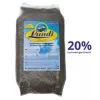
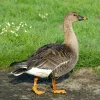

Floatable special rearing feed for all types of aquatic ornamental fowl - especially for the cultivation of trees as well as greening ducks.
This well-balanced complete feed with 20% protein content convinces above all by its good compatibility and forms the basis for visibly healthy growth from day one.
Made exclusively from wholesome and selected raw materials, Lundi Micro Regular is also ideally suited for the year-round feeding of waterfowl.
- Onderhoudsvoeder:
-



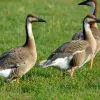

Lundi Regular with a protein content of 20%, valuable Spirulina and high-quality by-products is optimally balanced in its composition maintenance food for water ornamental fowl of all kinds. Especially green teal and Whistling ducks that are not dependent on a very high protein content, are well supplied.
Lundi Regular contains all the minerals and vitamins in full form that are important for the animals. Therefore also suitable as breeding food.


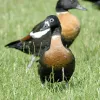


Floating full food for all sea ducks, green ducks, eider ducks and geese, especially in the moulting and breeding phase ideally suited. Packed with wholesome raw materials, natural vitamins and trace elements, this performance food with a protein content of 30% forms the basis for lifelong vitality.


